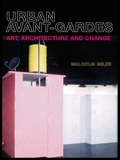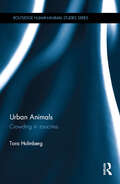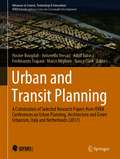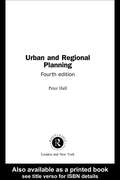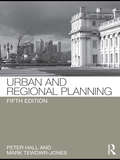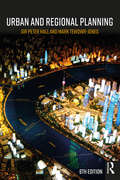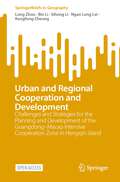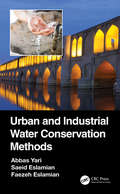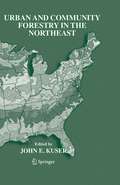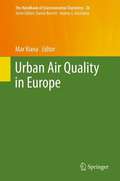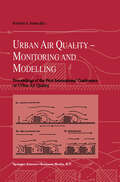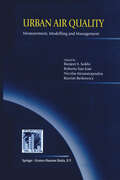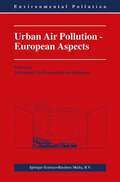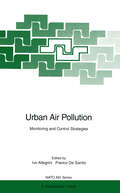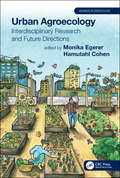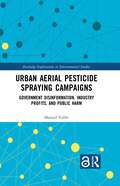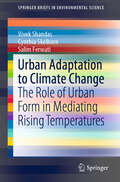- Table View
- List View
Urban Avant-Gardes: Art, Architecture and Change
by Malcolm MilesUrban Avant-Gardes presents original research on a range of recent contemporary practices in and between art and architecture giving perspectives from a wide range of disciplines in the arts, humanities and social sciences that are seldom juxtaposed, it questions many assumptions and accepted positions. This book looks back to past avant-gardes from the nineteenth and twentieth centuries examining the theoretical and critical terrain around avant-garde cultural interventions, and profiles a range of contemporary cases of radical cultural practices. The author brings together material from a wide range of disciplines to argue for cultural intervention as a means to radical change, while recognizing that most such efforts in the past have not delivered the dreams of their perpetrators. Distinctive in that it places works of the imagination in the political and cultural context of environmentalism, this book asks how cultural work might contribute to radical social change. It is equally concerned with theory and practice - part one providing a theoretical framework and part two illustrating such frameworks with examples.
Urban Avant-Gardes: Art, Architecture and Change
by Malcolm MilesUrban Avant-Gardes presents original research on a range of recent contemporary practices in and between art and architecture giving perspectives from a wide range of disciplines in the arts, humanities and social sciences that are seldom juxtaposed, it questions many assumptions and accepted positions. This book looks back to past avant-gardes from the nineteenth and twentieth centuries examining the theoretical and critical terrain around avant-garde cultural interventions, and profiles a range of contemporary cases of radical cultural practices. The author brings together material from a wide range of disciplines to argue for cultural intervention as a means to radical change, while recognizing that most such efforts in the past have not delivered the dreams of their perpetrators. Distinctive in that it places works of the imagination in the political and cultural context of environmentalism, this book asks how cultural work might contribute to radical social change. It is equally concerned with theory and practice - part one providing a theoretical framework and part two illustrating such frameworks with examples.
Urban Animals: Crowding in zoocities (Routledge Human-Animal Studies Series)
by Tora HolmbergThe city includes opportunities as well as constraints for humans and other animals alike. Urban animals are often subjected to complaints; they transgress geographical, legal as and cultural ordering systems, while roaming the city in what is often perceived as uncontrolled ways. But they are also objects of care, conservation practices and bio-political interventions. What then, are the "more-than-human" experiences of living in a city? What does it mean to consider spatial formations and urban politics from the perspective of human/animal relations?This book draws on a number of case studies to explore urban controversies around human/animal relations, in particular companion animals: free ranging dogs, homeless and feral cats, urban animal hoarding and "crazy cat ladies". The book explores ‘zoocities’, the theoretical framework in which animal studies meet urban studies, resulting in a reframing of urban relations and space. Through the expansion of urban theories beyond the human, and the resuscitation of sociological theories through animal studies literature, the book seeks to uncover the phenomenon of ‘humanimal crowding’, both as threats to be policed, and as potentially subversive. In this book, a number of urban controversies and crowding technologies are analysed, finally pointing at alternative modes of trans-species urban politics through the promises of humanimal crowding - of proximity and collective agency. The exclusion of animals may be an urban ideology, aiming at social order, but close attention to the level of practice reveals a much more diverse, disordered, and perhaps disturbing experience.
Urban Animals: Crowding in zoocities (Routledge Human-Animal Studies Series)
by Tora HolmbergThe city includes opportunities as well as constraints for humans and other animals alike. Urban animals are often subjected to complaints; they transgress geographical, legal as and cultural ordering systems, while roaming the city in what is often perceived as uncontrolled ways. But they are also objects of care, conservation practices and bio-political interventions. What then, are the "more-than-human" experiences of living in a city? What does it mean to consider spatial formations and urban politics from the perspective of human/animal relations?This book draws on a number of case studies to explore urban controversies around human/animal relations, in particular companion animals: free ranging dogs, homeless and feral cats, urban animal hoarding and "crazy cat ladies". The book explores ‘zoocities’, the theoretical framework in which animal studies meet urban studies, resulting in a reframing of urban relations and space. Through the expansion of urban theories beyond the human, and the resuscitation of sociological theories through animal studies literature, the book seeks to uncover the phenomenon of ‘humanimal crowding’, both as threats to be policed, and as potentially subversive. In this book, a number of urban controversies and crowding technologies are analysed, finally pointing at alternative modes of trans-species urban politics through the promises of humanimal crowding - of proximity and collective agency. The exclusion of animals may be an urban ideology, aiming at social order, but close attention to the level of practice reveals a much more diverse, disordered, and perhaps disturbing experience.
Urban and Transit Planning: A Culmination of Selected Research Papers from IEREK Conferences on Urban Planning, Architecture and Green Urbanism, Italy and Netherlands (2017) (Advances in Science, Technology & Innovation)
by Nancy Clark Hocine Bougdah Antonella Versaci Adolf Sotoca Ferdinando Trapani Marco MiglioreA volume of five parts, this book is a culmination of selected research papers from the second version of the international conferences on Urban Planning & Architectural Design for sustainable Development (UPADSD) and Urban Transit and Sustainable Networks (UTSN) of 2017 in Palermo and the first of the Resilient and Responsible Architecture and Urbanism Conference (RRAU) of 2018 in the Netherlands. This book, not only discusses environmental challenges of the world today, but also informs the reader of the new technologies, tools, and approaches used today for successful planning and development as well as new and upcoming ones. Chapters of this book provide in-depth debates on fields of environmental planning and management, transportation planning, renewable energy generation and sustainable urban land use. It addresses long-term issues as well as short-term issues of land use and transportation in different parts of the world in hopes of improving the quality of life. Topics within this book include: (1) Sustainability and the Built Environment (2) Urban and Environmental Planning (3) Sustainable Urban Land Use and Transportation (4) Energy Efficient Urban Areas & Renewable Energy Generation (5) Quality of Life & Environmental Management Systems. This book is a useful source for academics, researchers and practitioners seeking pioneering research in the field.
Urban and Regional Planning (PDF)
by Peter HallThis is the fourth edition of the classic text for students of urban and regional planning. It gives a historical overview of the developments and changes in the theory and practice of planning, throughout the entiretwentieth century.This extensively revised edition follows the successful format of previous editions. Specific reference is made to the most important British developments in recent times, including the devolution of Scotland, Wales and Northern Ireland, the establishment of the Mayor of London and the dominant urban sustainability paradigm.Planning in Western Europe, since 1945, now incorporates new material on EU-wide issues as well as updated country specific sections. Planning in the United States since 1945, now discusses the continuing trends of urban dispersal and social polarisation, as well as initiatives in land use planning and transportation policies.The book looks at the nature of the planning process at the end of the twentieth century and looks forward to the twenty-first century.
Urban and Regional Planning
by Peter HallThis is the fourth edition of the classic text for students of urban and regional planning. It gives a historical overview of the developments and changes in the theory and practice of planning, throughout the entiretwentieth century.This extensively revised edition follows the successful format of previous editions. Specific reference is made to the most important British developments in recent times, including the devolution of Scotland, Wales and Northern Ireland, the establishment of the Mayor of London and the dominant urban sustainability paradigm.Planning in Western Europe, since 1945, now incorporates new material on EU-wide issues as well as updated country specific sections. Planning in the United States since 1945, now discusses the continuing trends of urban dispersal and social polarisation, as well as initiatives in land use planning and transportation policies.The book looks at the nature of the planning process at the end of the twentieth century and looks forward to the twenty-first century.
Urban and Regional Planning
by Peter Hall Mark Tewdwr-JonesThis is the fifth edition of the classic text for students of urban and regional planning. It gives an historical overview of the developments and changes in the theory and practice of planning, throughout the entire twentieth century. This extensively revised edition follows the successful format of previous editions: it introduces the establishment of planning as part of the public health reforms of the late nineteenth century and goes on to look at the insights of the great figures who influenced the early planning movement, leading up to the creation of the post-war planning machine national and regional planning, and planning for cities and city regions, in the UK, from 1945 to 2010, is then considered. Specific reference is made to the most important British developments in recent times, including the Single Regeneration Budget, English Partnerships, the devolution of Scotland, Wales and Northern Ireland, the establishment of the Mayor of London and the dominant urban sustainability paradigm planning in Western Europe, since 1945, now incorporating new material on EU-wide issues, as well as updated country specific sections planning in the United States, since 1945, now discussing the continuing trends of urban dispersal and social polarisation, as well as initiatives in land use planning and transportation policies finally the book looks at the nature of the planning process at the start of the twenty-first century, reflecting briefly on shifts in planning paradigms since the 1960s and going on to discuss the main issues of the 1990s and 2000s, including sustainability and social exclusion and looking forward to the twenty-first century.
Urban and Regional Planning
by Peter Hall Mark Tewdwr-JonesThis is the fifth edition of the classic text for students of urban and regional planning. It gives an historical overview of the developments and changes in the theory and practice of planning, throughout the entire twentieth century. This extensively revised edition follows the successful format of previous editions: it introduces the establishment of planning as part of the public health reforms of the late nineteenth century and goes on to look at the insights of the great figures who influenced the early planning movement, leading up to the creation of the post-war planning machine national and regional planning, and planning for cities and city regions, in the UK, from 1945 to 2010, is then considered. Specific reference is made to the most important British developments in recent times, including the Single Regeneration Budget, English Partnerships, the devolution of Scotland, Wales and Northern Ireland, the establishment of the Mayor of London and the dominant urban sustainability paradigm planning in Western Europe, since 1945, now incorporating new material on EU-wide issues, as well as updated country specific sections planning in the United States, since 1945, now discussing the continuing trends of urban dispersal and social polarisation, as well as initiatives in land use planning and transportation policies finally the book looks at the nature of the planning process at the start of the twenty-first century, reflecting briefly on shifts in planning paradigms since the 1960s and going on to discuss the main issues of the 1990s and 2000s, including sustainability and social exclusion and looking forward to the twenty-first century.
Urban and Regional Planning
by Peter Hall Mark Tewdwr-JonesThis is the sixth edition of the classic text for students of urban and regional planning. It gives a historical overview of the developments and changes in the theory and practice of planning throughout the entire 20th and first part of the 21st centuries. The extensively revised edition incorporates the most important developments in recent times: debates on economic rebalancing and national infrastructure including high speed rail, energy, millennium projects, Celtic devolution, European influence, impact of London on nation. A new chapter "Planning for cities and city regions 1990-2017": includes new material on housing, localism, neighbourhood planning, privatisation, city modernism, reform, Devo and city deals and metro mayors. Urban and Regional Planning will be invaluable to undergraduate as well as postgraduate Planning students. It will prove useful in a variety of built environment areas such as Architecture, Landscape Architecture, Urban Design, Real Estate where planning is taught.
Urban and Regional Planning
by Peter Hall Mark Tewdwr-JonesThis is the sixth edition of the classic text for students of urban and regional planning. It gives a historical overview of the developments and changes in the theory and practice of planning throughout the entire 20th and first part of the 21st centuries. The extensively revised edition incorporates the most important developments in recent times: debates on economic rebalancing and national infrastructure including high speed rail, energy, millennium projects, Celtic devolution, European influence, impact of London on nation. A new chapter "Planning for cities and city regions 1990-2017": includes new material on housing, localism, neighbourhood planning, privatisation, city modernism, reform, Devo and city deals and metro mayors. Urban and Regional Planning will be invaluable to undergraduate as well as postgraduate Planning students. It will prove useful in a variety of built environment areas such as Architecture, Landscape Architecture, Urban Design, Real Estate where planning is taught.
Urban and Regional Cooperation and Development: Challenges and Strategies for the Planning and Development of the Guangdong–Macao Intensive Cooperation Zone in Hengqin Island (SpringerBriefs in Geography)
by Long Zhou Bin Li Sihong Li Ngan Leng Lei Kengfong CheongThis is an open access book. This book, first of all, introduces the new unveiled Guangdong-Macao Intensive Cooperation Zone with details as a special mode of the regional collaborative development that is committed to be mutually beneficial to both sides with different political and economic systems. China's central authorities have recently issued a masterplan for constructing the Guangdong-Macao Intensive Cooperation Zone at Hengqin Island in September 2021. As China's first and last European colony and one of China’s two special administrative regions (SARs), Macao has developed the gambling industry seven times larger than that of Las Vegas. However, the problem of the homogeneous industrial structure and the urgent need to promote sustainable economic growth by regional cooperation have been important theoretical and practical issues discussed by scholars and policy-makers. The Guangdong-Macao Intensive Cooperation Zone (ICZ) is managed under special customs supervision between two boarder lines and expected to diversify Macao’s economy. Then, this book dissects the theory of regional synergistic development and its applications in a number of international comparative and cross-interdisciplinary case studies worldwide. Finally, from the perspective of land use, transportation connection, and social service, this book thoroughly explores the challenges and strategies to implement the new cooperation model within the framework of one country, two systems, two customs, and two currencies to achieve a win–win situation using updated first-hand data collected by literature review, case study, field survey, spatial analysis, and interview.
Urban and Industrial Water Conservation Methods
by Abbas Yari Saeid Eslamian Faezeh EslamianUrban and Industrial Water Conservation Methods provides comprehensive and practical information regarding water use for various different sectors and describes the most suitable conservation devices and techniques to reduce water consumption in urban environments. It demonstrates how these conservation devices and best practices can greatly and quickly increase the efficiency of water use in both new and existing buildings. Features: Examines conservation devices and techniques across residential, commercial, and institutional sectors. Provides practical advice on implementing water conservation methods for users across various industries. Explains how to quickly improve water efficiency by using cost-effective water-saving devices and techniques. Includes relevant international case studies to reinforce the content. Written by practicing water conservation consultants for a wide audience, including municipality authorities and decision-makers, researchers, and students alike, Urban and Industrial Water Conservation Methods applies to residential, commercial, institutional, and industrial end users.
Urban and Industrial Water Conservation Methods
by Abbas Yari Saeid Eslamian Faezeh EslamianUrban and Industrial Water Conservation Methods provides comprehensive and practical information regarding water use for various different sectors and describes the most suitable conservation devices and techniques to reduce water consumption in urban environments. It demonstrates how these conservation devices and best practices can greatly and quickly increase the efficiency of water use in both new and existing buildings. Features: Examines conservation devices and techniques across residential, commercial, and institutional sectors. Provides practical advice on implementing water conservation methods for users across various industries. Explains how to quickly improve water efficiency by using cost-effective water-saving devices and techniques. Includes relevant international case studies to reinforce the content. Written by practicing water conservation consultants for a wide audience, including municipality authorities and decision-makers, researchers, and students alike, Urban and Industrial Water Conservation Methods applies to residential, commercial, institutional, and industrial end users.
Urban and Community Forestry in the Northeast
by John E. KuserThis book is a textbook for Urban/Community Forestry courses and a handbook for Shade Tree Commissions, tree wardens, State and National Forestry Services, and professional societies. It is the most complete text in this field because it addresses both culture and management, and the chapters have been written by experts who are active practitioners. The book provides observations and examples relevant to every urban center in the U.S. and elsewhere.
Urban Air Quality in Europe (The Handbook of Environmental Chemistry #26)
by Mar VianaThis book provides an overview of air quality in urban environments in Europe, focusing on air pollutant emission sources and formation mechanisms, measurement and modeling strategies, and future perspectives. The emission sources described are biomass burning, vehicular traffic, industry and agriculture, but also African dust and long-range transport of pollutants across the European regions. The impact of these emission sources and processes on atmospheric particulate matter, ozone, nitrogen oxides and volatile and semi-volatile organic compounds is discussed and critical areas for particulate matter and nitrogen dioxide in Europe are identified. Finally, this volume presents future perspectives, mainly regarding upcoming air quality monitoring strategies, metrics of interest, such as submicron and nanoparticles, and indoor and outdoor exposure scenarios.
Urban Air Quality: Proceedings of the First International Conference on Urban Air Quality: Monitoring and Modelling University of Hertfordshire, Hatfield, U.K. 11–12 July 1996
by Ranjeet S. SokhiThe increasing concern over environmental and health impact of urban air pollution has lead to a growing need for an international conference focussing specifically on urbanised regions. Although, air quality has gained importance through out the world, it is especially in areas of high urban development that the problems are particularly acute. Scientific interest in this field is particularly evident from the growing number of journal publications and conference presentations. The numerous conferences held every year on air pollution, however, have tended to encompass a broad theme and have not specifically focussed on the urban environment. In order to address this need an international conference on urban air quality was organised by the Environmental Physics Group of the Institute of Physics in collaboration with the Royal Society of Chemistry (RSC), The Royal Meteorological Society (RMS) and the National Society for Clean Air and Environmental Protection (NSCA). Over 100 participants from various countries attended this first international conference on urban air quality. The aim of the conference was to provide a forum for open scientific discussion on the latest advances in the field of urban air quality monitoring and modelling. The range of topics included: chemical and biogenic pollutants, monitoring techniques, instrumentation, analysis of pollutants, spatial and temporal interpretation of air quality data, emission sources and modelling of air quality. All papers submitted for publication were peer reviewed and consequently, some articles were not successful in the refereeing process and have not been included in this special issue.
Urban Air Quality: Proceedings of the Second International Conference on Urban Air Quality: Measurement, Modelling and Management Held at the Computer Science School of the Technical University of Madrid 3–5 March 1999
by Ranjeet S. Sokhi Roberto San José Nicolas Moussiopoulos Ruwim BerkowiczSince the first international conference on urban air quality, held at the University ofHertfordshire in 1996, significant advances have taken place in the field of urban air pollution. In addition to the scientific advances in the measurement, modelling and management of urban air quality, significant progress has been achieved in relation to the establishment of major frameworks to ensure a more effective mechanism for international collaboration. Two such frameworks are SATURN (Studying Atmospheric Pollution in Urban Areas) and TRAPOS (Optimisation of Modelling Methods for Traffic Pollution in Streets). In response to such advances, the second international conference was held at the Technical University of Madrid in March 1999 with active participation of SATURN and TRAPOS investigators. The organisation of the conference was headed by the Institute of Physics in collaboration with the Technical University of Madrid and the University of Hertfordshire. The support of IUAPPA and AWMA ensured a truly worldwide promotion and participation. The meeting attracted 140 scientists from 26 different countries establishing it as a major forum for exchanging and discussing the latest research fmdings in this field.
Urban Air Pollution - European Aspects (Environmental Pollution #1)
by Brian J. AllowayThis European Community-initiated book presents an up-to-date account of the air pollution situation with special reference to European cities. Its structure follows by and large the logical chain of events in air pollution, from sources, through dispersion and deposition, to impacts.
Urban Air Pollution: Monitoring and Control Strategies (Nato Science Partnership Subseries: 2 #8)
by Ivo Allegrini Franco DeSantisThis book presents the proceedings of a NATO Advanced Research Workshop which was also financially supported by the National Research Council of Italy. The Workshop was held from October 9 to 15, 1994, at the Centro Ettore Maiorana in Erice, Italy. Over 40 researchers from a wide variety of fields attended the Workshop, which brought to attention the ongoing research on various phenomena related to urban air pollution. The presence of high levels of atmospheric pollutants in the air of several urban centres of developed and developing countries causes a great concern among authorities and public opinion. Some 20% of the European population live in cities of more than 500,000 inhabitants and about 40% in cities of more than 50,000. Since exceedance of the Air Quality Guidelines has been observed to occur worldwide, a great effort has been addressed to the control of primary pollutants, but many problems related to secondary pollutants such as nitrogen containing species (nitrogen oxides, nitric and nitrous acid, ni trates) and photochemical oxidants (ozone, PAN and others) are far from being solved. The importance of atmospheric chemistry in understanding the processes occurring in urban atmospheres has been well recognised, thus there is a strong need to exchange experiences and results from urban centres in different Countries. Indeed, atmospheric pollution is very much dependent on the type of emissions which are very different according to the economic development of the urban centre under consideration.
Urban Agroecology: Interdisciplinary Research and Future Directions (Advances in Agroecology #23)
by Monika Egerer Hamutahl CohenToday, 20 percent of the global food supply relies on urban agriculture: social-ecological systems shaped by both human and non-human interactions. This book shows how urban agroecologists measure flora and fauna that underpin the ecological dynamics of these systems, and how people manage and benefit from these systems. It explains how the sociopolitical landscape in which these systems are embedded can in turn shape the social, ecological, political, and economic dynamics within them. Synthesizing interdisciplinary approaches in urban agroecology in the natural and social sciences, the book explores methodologies and new directions in research that can be adopted by scholars and practitioners alike. With contributions from researchers utilizing both social and natural science approaches, Urban Agroecology describes the current social-environmental understandings of the science, the movement and the practices in urban agroecology. By investigating the role of agroecology in cities, the book calls for the creation of spaces for food to be sustainably grown in urban spaces: an Urban Agriculture (UA) movement. Essential reading for graduate students, practitioners, policy makers and researchers, this book charts the course for accelerating this movement.
Urban Agroecology: Interdisciplinary Research and Future Directions (Advances in Agroecology #23)
by Monika Egerer Hamutahl CohenToday, 20 percent of the global food supply relies on urban agriculture: social-ecological systems shaped by both human and non-human interactions. This book shows how urban agroecologists measure flora and fauna that underpin the ecological dynamics of these systems, and how people manage and benefit from these systems. It explains how the sociopolitical landscape in which these systems are embedded can in turn shape the social, ecological, political, and economic dynamics within them. Synthesizing interdisciplinary approaches in urban agroecology in the natural and social sciences, the book explores methodologies and new directions in research that can be adopted by scholars and practitioners alike. With contributions from researchers utilizing both social and natural science approaches, Urban Agroecology describes the current social-environmental understandings of the science, the movement and the practices in urban agroecology. By investigating the role of agroecology in cities, the book calls for the creation of spaces for food to be sustainably grown in urban spaces: an Urban Agriculture (UA) movement. Essential reading for graduate students, practitioners, policy makers and researchers, this book charts the course for accelerating this movement.
Urban Aerial Pesticide Spraying Campaigns: Government Disinformation, Industry Profits, and Public Harm (Routledge Explorations in Environmental Studies)
by Manuel ValléeThis book examines social processes that have contributed to growing pesticide use, with a particular focus on the role governments play in urban aerial pesticide spraying operations.Beyond being applied to sparsely populated farmland, pesticides have been increasingly used in densely populated urban environments, and when faced with invasive species, governments have resorted to large-scale aerial pesticide spraying operations in urban areas. This book focuses on New Zealand's 2002–2004 pesticide campaign to eradicate the Painted Apple Moth, which is the largest operation of its kind in world history, whether we consider its duration (29 months), its scope (at its peak the spraying zone was 10,632 hectares/26,272 acres), the number of sprayings that were administered (the pesticide was administered on 60 different days), or the number of people exposed to the spraying (190,000+). This book provides an in-depth understanding of the social processes that contributed to the incursion, why the government sought to eradicate the moth through aerial pesticide spraying, the ideological strategies they used to build and maintain public support, and why those strategies were effective.Urban Aerial Pesticide Spraying Campaigns will be of great interest to students and researchers of pesticides, environmental sociology, environmental history, environmental studies, political ecology, geography, medical sociology, and science and technology studies.The Open Access version of this book, available at http://www.taylorfrancis.com, has been made available under a Creative Commons Attribution-Non Commercial-No Derivatives (CC-BY-NC-ND) 4.0 license.
Urban Aerial Pesticide Spraying Campaigns: Government Disinformation, Industry Profits, and Public Harm (Routledge Explorations in Environmental Studies)
by Manuel ValléeThis book examines social processes that have contributed to growing pesticide use, with a particular focus on the role governments play in urban aerial pesticide spraying operations.Beyond being applied to sparsely populated farmland, pesticides have been increasingly used in densely populated urban environments, and when faced with invasive species, governments have resorted to large-scale aerial pesticide spraying operations in urban areas. This book focuses on New Zealand's 2002–2004 pesticide campaign to eradicate the Painted Apple Moth, which is the largest operation of its kind in world history, whether we consider its duration (29 months), its scope (at its peak the spraying zone was 10,632 hectares/26,272 acres), the number of sprayings that were administered (the pesticide was administered on 60 different days), or the number of people exposed to the spraying (190,000+). This book provides an in-depth understanding of the social processes that contributed to the incursion, why the government sought to eradicate the moth through aerial pesticide spraying, the ideological strategies they used to build and maintain public support, and why those strategies were effective.Urban Aerial Pesticide Spraying Campaigns will be of great interest to students and researchers of pesticides, environmental sociology, environmental history, environmental studies, political ecology, geography, medical sociology, and science and technology studies.The Open Access version of this book, available at http://www.taylorfrancis.com, has been made available under a Creative Commons Attribution-Non Commercial-No Derivatives (CC-BY-NC-ND) 4.0 license.
Urban Adaptation to Climate Change: The Role of Urban Form in Mediating Rising Temperatures (SpringerBriefs in Environmental Science)
by Vivek Shandas Cynthia Skelhorn Salim FerwatiThis book presents the findings of a three-year study on urban heat in Doha, Qatar, and discusses guidelines and strategies for planning agencies to consider in the context of moderating temperatures to provide pedestrians with greater access to outdoor spaces and greater choice in modes of transport. If modifying urban form can reduce extreme temperatures in one of the hottest places on the planet, then perhaps other communities can learn how to create livable cities during a time of rapid changes to the climate. In fact, despite the periods of extreme heat, strategic planning and management of urban areas can improve residents’ and visitors’ ability to live, work, and move throughout the city comfortably. Doha, Qatar, a city with one of the most extreme climates on earth, has undergone rapid development over the past 40 years. Although cities in the Middle East are expanding at three times the international average (UN Report, 2012), the rapid population and physical growth remain largely unexamined, particularly in terms of the unique conditions, qualities, and characteristics that give rise to these emerging centres. Speed, quality, and extent of urbanization impact neighbourhood-scale environmental conditions, and this book provides evidence that urban forms and materials can help to mediate temporal variation in microclimates and that landscape modifications can potentially reduce temperatures and increase accessibility to outdoor environments. By applying the lessons in this book, communities around the world can better adapt to the increasing frequency, duration and intensity of extreme heat.
